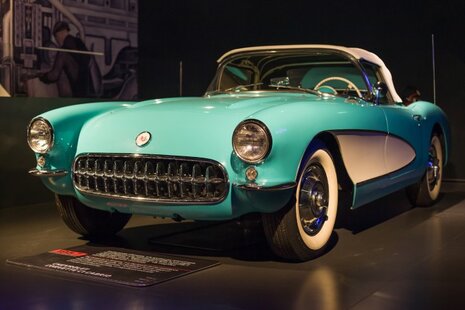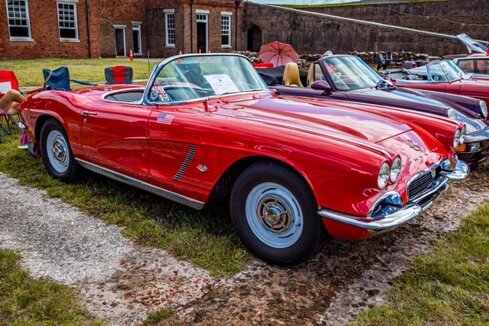C1 Facts
Corvette 1953 – 1962 (the one that started it all)
History of the C1 Corvette 1953-1962
 The C1 Corvette, designed by Harley Earl, is a fiberglass-bodied two-seater that was introduced at the Motorama car show at the Waldorf-Astoria Hotel in New York in 1953. The Corvette was named after a fast naval attack ship.
The C1 Corvette, designed by Harley Earl, is a fiberglass-bodied two-seater that was introduced at the Motorama car show at the Waldorf-Astoria Hotel in New York in 1953. The Corvette was named after a fast naval attack ship.The initial production run in 1953 consisted of 300 vehicles, exclusively offered to GM's VIP customers. The starting price of $3,500 featured a 150 HP six-cylinder engine with triple single barrel carburetors and a Powerglide 2-speed automatic transmission. Customers had only one-color option: white with a red interior. This limited release faced challenges, as fewer than 300 units were sold, prompting GM to consider discontinuing the model. However, with Ford poised to launch their two-seater Thunderbird, GM decided to persevere with the Corvette. In the following year, GM eliminated the VIP policy, making the car available to the general public.
By 1955, fewer than 3,000 out of the planned 10,000 cars had been built.
 In 1956, the Corvette was equipped with a 265 cubic inch engine that featured dual 4-barrel carburetors and produced 225 horsepower. By 1957, the engine displacement had increased to 283 cubic inches, available in three versions: 220 horsepower with a single 4-barrel carburetor, 245 horsepower with dual 4-barrel carburetors, and the new 283 horsepower Ramjet fuel injection. Corvettes subsequently began setting speed records on the racing circuit. Additionally, the Corvette gained prominence when it was featured in the popular television show "Route 66" in 1960, which depicted two young men traveling across America in a Corvette.
In 1956, the Corvette was equipped with a 265 cubic inch engine that featured dual 4-barrel carburetors and produced 225 horsepower. By 1957, the engine displacement had increased to 283 cubic inches, available in three versions: 220 horsepower with a single 4-barrel carburetor, 245 horsepower with dual 4-barrel carburetors, and the new 283 horsepower Ramjet fuel injection. Corvettes subsequently began setting speed records on the racing circuit. Additionally, the Corvette gained prominence when it was featured in the popular television show "Route 66" in 1960, which depicted two young men traveling across America in a Corvette. In 1958, dual headlights were introduced, and the fuel-injected engine's HP increased to 290.
The 1959 model introduced a close-ratio 4-speed transmission. The design was refined by removing some of the chrome accents and the non-functional hood louvers. Additionally, a new variant of the 283 V8 engine was offered, including an option for a second fuel-injection motor.
In 1960, the Corvette's rear design transitioned from a rounded back to the more recognizable pointed rear quarter panels with four round taillights. This rear design persisted until 1967. Engine enhancements led to an increase in horsepower, with the top fuel-injected engine now producing 315 HP. The vehicle also underwent minor styling changes and achieved a small weight reduction due to the introduction of an aluminium bell housing.
In 1961, Corvette production exceeded 10,000 units, all of which were convertibles.
 The 1962 model year marked the debut of the 327-cubic inch engine and represented the final year of the C1 series.
The 1962 model year marked the debut of the 327-cubic inch engine and represented the final year of the C1 series.